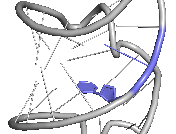Welcome
Viral RNA genomes are not only used passively to store genetic information, but are also organized structurally into domains that play active roles in the viral life cycle. The lab’s research centers on understanding how RNA viruses, and more recently, eukaryotic cells, utilize RNA domains in conjunction with the host cell machinery and environment to achieve critical functions. Namely, we are interested in identifying molecular mechanisms used in internal ribosome entry site (IRES) utilization, ribosomal recoding during protein translation, mRNA transcription in both viruses and eukaryotic systems, and retroviral reverse transcription initiation. Because these processes are regulated by interactions between the RNA domains and cellular factors, our research also informs on mechanisms that are fundamental to cellular biology. Furthermore, it is becoming increasingly clear that the ability of RNA structures to adapt and change conformations steers an incredible number of biological functions— from genome organization to protein synthesis. By bridging the fields of biophysics, biochemistry, structural biology and virology, our studies are tailored to uncover structural and mechanistic principles that may govern such RNA-mediated processes.
While many researchers have approached structural studies of RNA domains in the last three decades, the relatively low probability of these domains crystallizing or the complexity of studying these by nuclear magnetic resonance (NMR) has made this a challenging problem. Our lab is using advanced NMR methods, in conjunction to crystallography and CryoEM, to meticulously assign spectra of large RNA and protein-RNA complexes to finally gain insights into the many open questions in the field.
